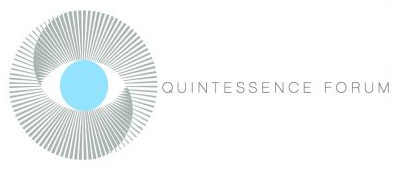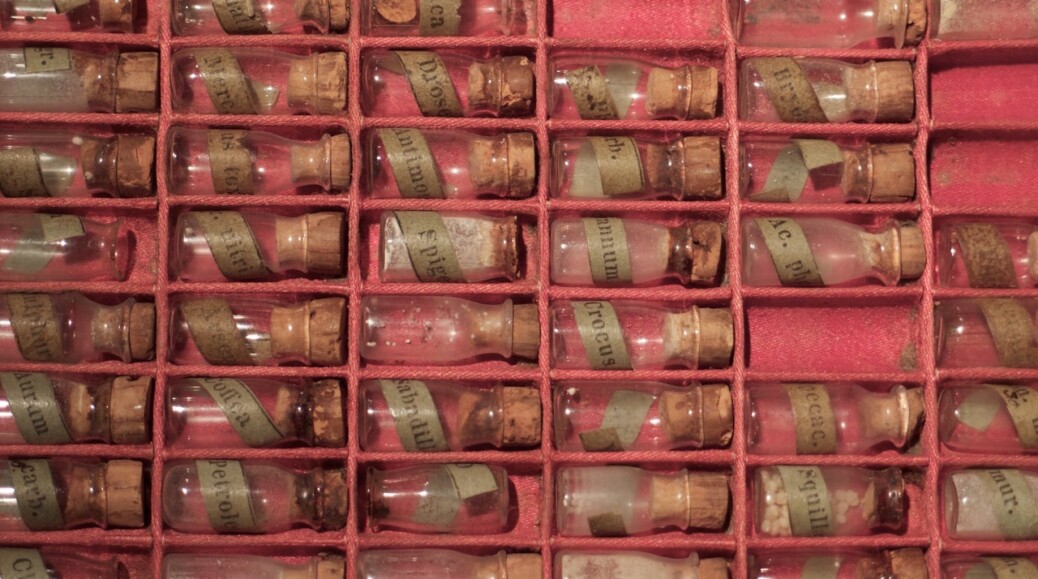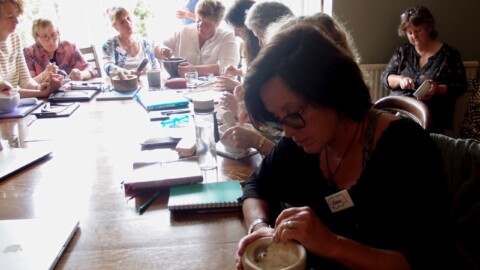Misha Norland
We live in perilous times. We are experiencing climate change, a pandemic, WW debit, pollution, overuse of antibiotics, medical warnings about compromised immunity, addiction and behaviour that is increasingly unpredictable and often violent. If you were not genuinely seeking solutions, you would not be looking here. I contend that in today’s world the place of homeopathy’s philosophical and scientific understanding, and of course, its practice seems more relevant than ever.
Homeopathy
Homeopathy is an integrated medical, mind-body therapy that promotes self-healing. This means every patient is seen as a unique individual rather than a diagnosis or syndrome. In this way, and through careful and detailed observation and enquiry, the homeopathic practitioner learns which specific homeopathic medicine to select to re-establish compromised health, generating wellbeing and creativity. Because the medicine is tailored to match individual symptoms and is prepared (potentised) to match individual susceptibility, it spares us from the side effects, dependencies and merely palliative treatment common to pharmaceutically based methods. A homeopathic prescription is chosen according to a manner defined and systematized by Samuel Hahnemann, the founder of Homeopathy, who was born in 1755 in Meissen, Germany.
The principle of similarity
Homeopathy is based upon the application of the principle of similarity, finding correspondences between a substance ‘out there’ and the internal disturbance, the sickness ‘in here’. For instance, fresh onion juice provokes profuse and burning tears, (action of the substance ‘out there’) while for a patient with profuse, burning tears, it acts curatively, quelling that patient’s allergic response to an allergen. The immune response after inoculation, where an attenuated virus of the same or similar disease stimulates an immunological reaction, is a homeopathic response. However, the multiple routine immunization of whole populations is questioned by many homeopaths, on the basis that acute inflammatory responses to infection should be treated at the time they arise with appropriate homeopathic remedies. This promotes the development of a healthy immune system and does not give rise to iatrogenic sequalae.
Homeopaths understand that any time an acute condition is maltreated or suppressed (and this includes routine immunization) or through excessive use of chemical drugs, the body’s natural line of defence will be suppressed. This in turn marks the beginnings of all manner of chronic conditions that are likely to manifest, usually many years later. Acute inflammatory conditions must, therefore, be treated very carefully from their beginnings in childhood in order not to force the immune system into a compromised position.
The homeopathic stimulus afforded by the similar medicine is greatest when the quantity of the dose is smallest, but energized. This is referred to as potentisation by homeopaths. As has been observed by immunologists, the smallest, and according to homeopaths, especially energized doses of allergens stimulate responses in sensitive individuals. Homeopaths understand, that healing action is dynamic, and that physical results follow shifts in the body’s energy.
When Einstein wrote his elegant formula for the conversion between matter and energy, there were many dissenters until the explosion of the atom bomb dispelled all doubt. Furthermore, the more we investigate the laws of quantum physics, the more we come to realise that what appear to be particles (matter) are rather manifestations of electromagnetic waves, which in turn are vibrating fields of energy. Einstein said, “We may therefore regard matter as being constituted by the regions of space in which the field is extremely intense… There is no place in this new kind of physics both for the field and matter, for the field is the only reality.”
Non-material influences and homeopathic pharmacy
The action of non-material influences are ubiquitous, we cannot get away from them. There is nothing material in the mood generated when we are in a field of hatred, or worry, or uncertainty, yet they undoubtedly trouble us. By way of another example, when the one we hope may be keen on us sends an affirmation, exclaiming, “I love you!” we will certainly experience wellsprings of joy, yet there is nothing actually there to locate or to measure. It is the intention, the focus and the receptivity to that field which is of the moment. Our understanding, in the practice of healing, is that the receptive capacity of any organism (especially in the acute phase) is increased in direct proportion to their sickness. Therefore, the dose of a curative agency need not be material (where it would likely cause side effects), because ‘the receptive’ is open and primed for the stimulus in the correct and suitably energized dosage.
In homeopathic pharmacy, a material substance, be it gold or onion, is usually the starting point in the manufacture of medicine. However, this is not necessarily so. The healing agents themselves are not necessarily of material origin. By way of example consider magnetism and X-ray, which are available as a homeopathically prepared medicines. We mention this because reaction by living organisms is always dynamic, whatever the source of the homeopathically prepared medicine may be. The dynamic agency in the body that is the intermediary between substance and energy is known as the vital force. This may be an archaic term but is a beautifully serviceable one. Quoted below are the ninth and tenth paragraphs by Samual Hahnemann in his seminal work of 1810, ‘The Organon of the Art of Healing.’ It is here translated into English.
The vital force
In the healthy condition of man, the spiritual vital force is the dynamis that animates the material body. It rules with unbounded sway, and retains all the parts of the organism in admirable, harmonious, vital operation, as regards both sensations and functions, so that our indwelling, reason-gifted mind can freely employ this living, healthy instrument for the higher purpose of our existence.
The material organism, without the vital force, is capable of no sensation, no function, no self-preservation, it is dead, and only subject to the power of the external physical world; it decays, and is again resolved into its chemical constituents.
The vital force, as Hahnemann defines it, is the information field that directs all the responses of the organism, telling the body how to act and respond. It is an invisible or spiritual force that orders, marshals and coordinates the physical body according to intrinsic and inherited energy patterns (genetic and epigenetic information). When it is distorted because of disease, or misdirected because of failure to respond adequately to stress, then functional and structural changes occur. In other words we fall sick.
When medicines are offered to the sick organism according to similarity and in infinitesimally small, energized doses, it is to the spiritual vital force that they are directed. The vital force acts as a bridge between the medicine and the deranged organism, allowing the homeopathic effect to manifest in cure. Now it stands revealed that the prepared medicine, that is no longer material, but potentised and vital in its nature, addresses the vital force, because it ‘speaks the same language’.
In medical parlance, the protective action of the vital force is often referred to as the immune defense system. This is misleading because the latter is not the invisible vital force although it is electively susceptible to its influence, not its master, but its servant. We could say that the ‘dispute’ between the vital force together with its servant, the immune defense system, with the destructive force of the disease or malefic state of mind/emotion, is that which produces disease and its symptoms. These are the voices, if you will, of the dispute. They are amplified, made louder by the resonance of the healer’s attention, so that it shall not be missed but will indeed be witnessed.
The healer listens to the patient, witnesses the disturbance and when appropriate helps to amplify the response, so that the exact nature of the symptoms are exposed. Then an agent out there (the medicine) is sought that will match that state, and then, like cures like.
Knowledge of medicines
In order to understand the action of medicines, homeopathic investigators conduct proving’s. Provings were another of Hahnemann’s brainchildren. In a proving, a group of volunteers of both sexes are given an energized dose or doses of the substance under enquiry. The provers do not know what the substance is. Over a period of time (usually about two months) and under close supervision, they keep an on-going log of their altered state. They examine not only new and/or changed physical symptoms, but also mental and psychological symptoms. Provers are in effect the living instruments upon whom the melody of the medicinal substance is being played.
At the end of the proving, the logged information is gathered from all the volunteers and collated. During this process, it is established which symptoms are frequently, moderately, and least powerfully experienced. This organization of symptoms constitutes the ‘picture’ of the healing agent. It is verified and enlarged upon by subsequent clinical experience.
Treating a person homeopathically is the opposite process to a proving. During a proving we create a temporary sickness. While during a cure, we give a sick person the medicine that would cause similar symptoms in a healthy person. The vital force responds in reaction, with the result that the symptoms of the sickness lessen and disappear.
The proving method of testing substances and energies in the laboratory of the human body is one of the features that puts homeopathy on a scientific basis, in that ‘science’ refers to knowledge that is systematic, repeatable and verifiable.
Materia Medica and Repertory
The Materia Medica of homeopathy lists the proving symptoms for that medicine, plus clinical observations of symptoms cured in people who have taken it. If the medicine is made from a poison, toxicological symptoms are included, detailing clinical observations of its victims. The symptoms gathered in the Materia Medica form the basis of the other main tool of homeopathy, the Repertory. Literally this is an inventory or storehouse where things may be found. The homeopathic Repertory is an index of the symptoms, with each heading listing those medicines known to cause and cure that symptom. The medicines are listed to show prominence, from the most frequently occurring to the least. The Materia Medica has always expanded and continues to do so as new medicines are added to the homeopathic toolkit. The Repertory also expands to include the observations of new provers and the latest findings from clinical practice. Thus both the Materia Medica and the Repertory are storehouses of clinical experience detailing the outward manifestations of the inner spirit of each medicine
Pharmacy
The making of medicines for homeopathic usage is unique, involving successive serial dilution coupled with simultaneous energisation/potentisation of the material. This step by step process produces medicines that have increasing capacity to provoke a dynamic response in the patient. The idea is to increase medicinal action on the vital plane, while reducing the quantity of material substance and hence gross poisoning effects.
Higher potencies are most suitable for long-term problems in resilient individuals, and also in treating life-threatening accidents and emergencies. Lower potency is considered a safer option for general usage and for self-medicating individuals.
It is in respect of the potentising of medicines that homeopathy has come to be disrespected in some cultures. It is considered unscientific because its unique potentising methodology flies in the face of an apparently rational explanation according to materialistic scientific understanding. This view states, if there is nothing in it, then it cannot work.
The nature of influence and the vital force
When we carry out a proving, the experience is analogous to becoming temporarily ill; it is similar in its action to epidemic contagion. In both instances, the influence overwhelms individuals, and many personal idiosyncrasies are temporarily submerged under the common symptoms of the influence. Insofar as this is the case, a proving group reacts and speaks as if it were one person. While each individual reveals only some aspects of the proving, the group of provers reveals most. The influx alters inner states which are apprehended initially through changed sensations, the emergence of images, feelings, and dreams, and later through the production of physical symptoms.
Since the development of microscopy, medical science has become solidly wedded to germ theory. Of course germs are very real and attack us when our defenses are weakened. The question is, what is it that has caused the breach in the defense. Homeopaths understand that it is the derangement of the spiritual vital force that expresses itself in the production of symptoms. Without going into details about causation (a difficult thing to pinpoint, since there are usually a number of conditions which conspire together) we have no trouble in agreeing that symptoms are the result (effects) of an interplay of inimical affects and the vital force whose station it is to maintain homeodynamis and health. This drama is played out in the invisible interior of the organism, as Hahnemann expresses it, in the vital field, before the defense mechanism kicks in and other tangible effects are noted. This drama gives rise to dynamic disturbances such as altered sensations and feelings before physical and measurable changes manifest.
It is the vital plane, the field of dynamic action and reaction with which a homeopath concerns him/herself. Homeopathically prepared medicines address this field because they are likewise of a spiritual/vital nature.
Let us review a few other examples of dynamic action. A good performance of music affects the audience, who, as if one, respond to its influence. Another example is afforded by any powerful orator, who like a magician (this is how Hitler described his powers), affects the crowd. As is clear from the example of Hitler, it is not so much the words, it is the intention, the delivery and the ritualistic aspects of the meeting that together set up the influence. When we do a group proving, some aspects of ritual are inevitably and usefully present. The intention to convey the influence is there, as well as the intention to receive it. When we administer a remedy to a fellow sufferer (our patient), a similar grouping of influences are present. I am referring here to the patient/practitioner dynamic, as well as the dynamic of remedy administration. (Placebo effect accounts for much curing because some of these ritual elements are present, although not the potentised medicine.)
Physics abounds with examples of similar effects where vibrating electromagnetic fields travel through space. These phenomena are neither mystical nor supernatural; they obey innate laws which took some time for man to understand but which are scientifically valid despite our backwardness of understanding. In fact, the more we investigate the laws of quantum physics, the more we come to realise that what appear to be particles (matter) are rather manifestations of electromagnetic waves, which in turn are merely vibrating fields of energy. As we quoted earlier, Einstein himself, who is surely not lacking in ‘hard’ scientific credentials, said, “We may therefore regard matter as being constituted by the regions of space in which the field is extremely intense… There is no place in this new kind of physics both for the field and matter, for the field is the only reality.”



